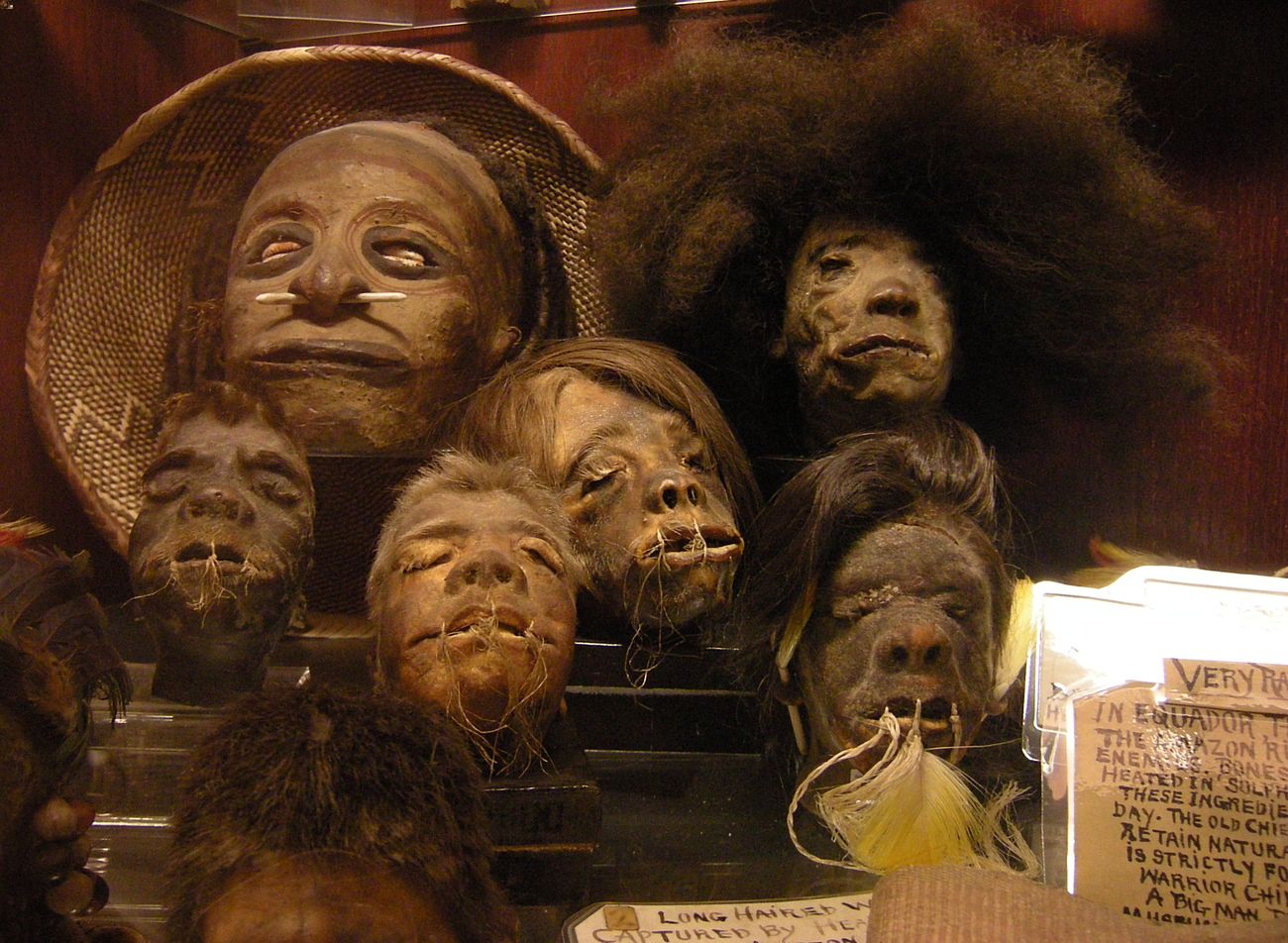
Shrunken heads, also known as tsantsas, have fascinated people for centuries. These eerie artifacts come from the Jivaroan tribes in the Amazon rainforest, primarily the Shuar, Achuar, Huambisa, and Aguaruna. But what exactly are they? Shrunken heads are human heads that have been prepared and shrunk as part of a ritual. The process involves removing the skull, treating the skin, and then shrinking it to about one-third of its original size. This practice was believed to harness the spirit of the enemy and prevent it from seeking revenge. Today, these heads are rare and often found in museums or private collections. However, their history and cultural significance continue to intrigue many. Let's dive into 38 fascinating facts about these mysterious objects.
Key Takeaways:
- Shrunken heads, also known as tsantsas, were made by Amazon tribes and used in rituals. They were believed to trap the spirit of enemies and had cultural significance for the tribes.
- Shrunken heads have made their way into popular culture, appearing in movies, TV shows, and even theme parks. While the practice has largely died out, they still hold a place in modern culture and history.
What Are Shrunken Heads?
Shrunken heads, also known as tsantsas, are a fascinating yet eerie part of history. These macabre objects have intrigued people for centuries. Let's dive into some intriguing facts about them.
- Shrunken heads were primarily made by the Jivaroan tribes in the Amazon rainforest, particularly the Shuar, Achuar, Huambisa, and Aguaruna tribes.
- The process of creating a shrunken head involved removing the skull and flesh, then boiling the skin and sewing the eyes and mouth shut.
- Shrunken heads were often used in rituals and were believed to contain the spirit of the person they once belonged to.
- The Jivaroan tribes believed that shrinking the head of an enemy would trap their soul and prevent them from taking revenge.
- The practice of head shrinking was not just for enemies; sometimes, it was done to honor deceased loved ones.
- Shrunken heads were also used as trophies of war, symbolizing victory and power over enemies.
- The process of making a shrunken head could take several days and required great skill and knowledge.
- The heads were often decorated with beads, feathers, and other ornaments to enhance their appearance.
- Shrunken heads were sometimes traded or sold to outsiders, particularly during the 19th and early 20th centuries.
The Process of Making Shrunken Heads
Creating a shrunken head was a meticulous and ritualistic process. Here are some detailed steps involved in this ancient practice.
- First, the head was severed from the body, and an incision was made at the back of the neck to remove the skull.
- The skin was carefully peeled away from the skull, taking care not to damage the facial features.
- The skin was then boiled in a mixture of water and herbs to shrink it and preserve it.
- After boiling, the skin was dried using hot stones and sand, which helped to further shrink and shape the head.
- The eyes and mouth were sewn shut to prevent the spirit from escaping.
- The head was then smoked over a fire to harden and darken the skin.
- The final product was often treated with oils and resins to give it a glossy finish.
Cultural Significance of Shrunken Heads
Shrunken heads held deep cultural significance for the tribes that made them. They were more than just macabre curiosities.
- The Jivaroan tribes believed that shrunken heads possessed magical properties and could bring good fortune or protection.
- They were often used in rituals to communicate with ancestors or spirits.
- Shrunken heads were sometimes used in healing ceremonies to cure illnesses or ward off evil spirits.
- They were also believed to have the power to control the weather or influence the outcome of battles.
- The process of making a shrunken head was often accompanied by prayers and chants to invoke the spirits.
- Shrunken heads were sometimes buried with their owners to protect them in the afterlife.
Shrunken Heads in Popular Culture
Shrunken heads have made their way into popular culture, appearing in movies, books, and even theme parks.
- Shrunken heads have been featured in movies like "Beetlejuice" and "Harry Potter and the Prisoner of Azkaban."
- They have also appeared in TV shows like "The X-Files" and "Supernatural."
- Shrunken heads are a popular attraction at Ripley's Believe It or Not! museums around the world.
- They have inspired countless horror stories and legends, adding to their mystique and allure.
- Shrunken heads have even been used as props in haunted houses and Halloween decorations.
Modern-Day Shrunken Heads
While the practice of making shrunken heads has largely died out, they still hold a place in modern culture and history.
- Authentic shrunken heads are rare and highly sought after by collectors and museums.
- Many shrunken heads on the market today are actually replicas or fakes made from animal hides or synthetic materials.
- Some indigenous tribes still make shrunken heads for ceremonial purposes, but they are not used in the same way as they were in the past.
- Shrunken heads have been the subject of scientific study, with researchers examining their construction and preservation methods.
- They have also been used in forensic science to study the effects of different preservation techniques on human tissue.
- Shrunken heads have been featured in art exhibitions and cultural displays, highlighting their historical and cultural significance.
Ethical Considerations and Controversies
The history and trade of shrunken heads raise several ethical questions and controversies.
- The trade of shrunken heads has been criticized for exploiting indigenous cultures and commodifying their sacred practices.
- Some museums and collectors have faced backlash for displaying shrunken heads without proper context or respect for their cultural significance.
- There have been calls to repatriate shrunken heads to their countries of origin, where they can be properly cared for and respected.
- The sale of shrunken heads is illegal in many countries, and there are strict regulations governing their trade and display.
- Despite these controversies, shrunken heads continue to captivate and intrigue people around the world, serving as a reminder of the complex and often dark history of human culture.
The Fascinating World of Shrunken Heads
Shrunken heads, or tsantsas, offer a glimpse into the rich culture of the Jivaroan tribes of Ecuador and Peru. These artifacts, once used in rituals and as trophies, have captivated historians and collectors alike. The process of creating a shrunken head involves removing the skull, boiling the skin, and then shrinking it using hot stones and sand. This meticulous method preserves facial features, making each tsantsa unique.
While authentic shrunken heads are rare and often found in museums, many replicas exist due to their popularity. It's important to recognize the cultural significance and respect the traditions behind these artifacts. Understanding the history and meaning of shrunken heads helps us appreciate the diverse practices of indigenous peoples. So next time you see a shrunken head, remember the fascinating history and craftsmanship that went into its creation.
Frequently Asked Questions
Was this page helpful?
Our commitment to delivering trustworthy and engaging content is at the heart of what we do. Each fact on our site is contributed by real users like you, bringing a wealth of diverse insights and information. To ensure the highest standards of accuracy and reliability, our dedicated editors meticulously review each submission. This process guarantees that the facts we share are not only fascinating but also credible. Trust in our commitment to quality and authenticity as you explore and learn with us.


